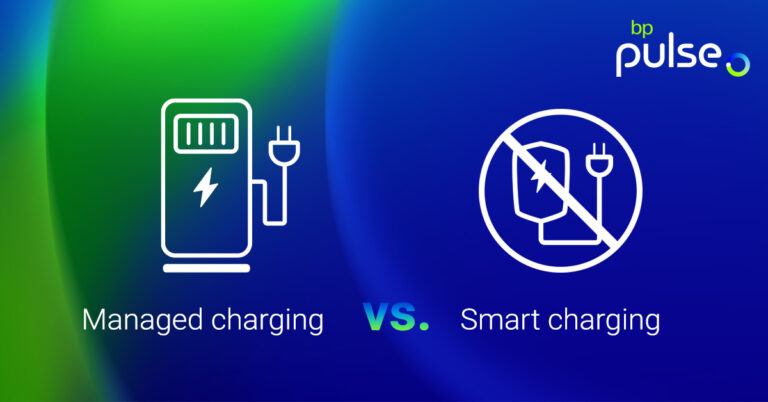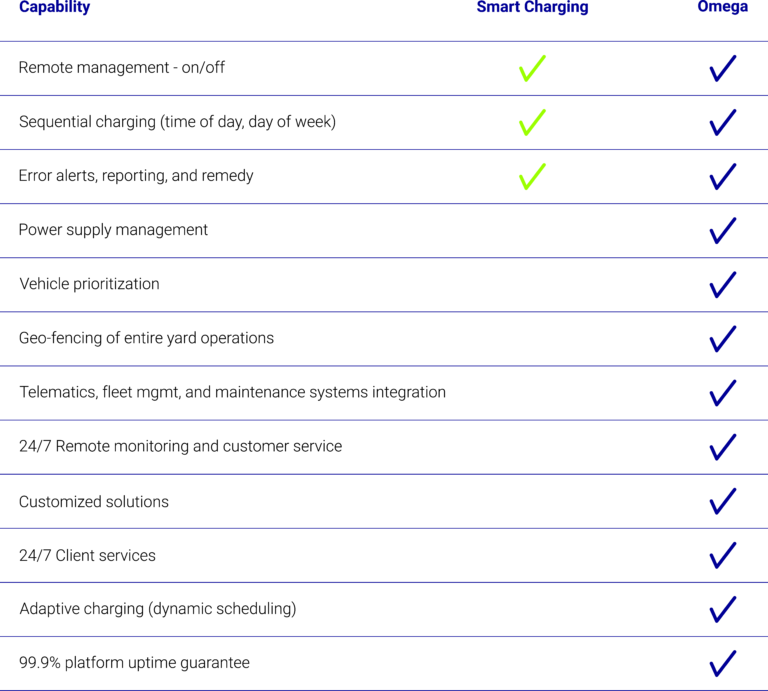managed charging
EV Fleets 101: The benefits of managed charging
Managed charging goes above and beyond to provide real value to fleets.

With the electrification movement well underway, fleets are introduced to a whole new glossary of terms and an ever-evolving list of key considerations for selecting vehicle technology, charging infrastructure, and route optimization tools.
Relative to charging their fleets, organizations are tasked with optimizing fleet charging costs — facing the choice between smart or managed charging technology. What’s the difference you ask? Keep reading below to find out.
What is smart charging?
When people hear the term ‘smart charging’, often what they envision are the abilities that managed charging offers, but that’s not the case. Simply put, smart charging refers to the actual charger hardware for electric vehicles (EVs) — the physical interface.
While the intent is not to be deceptive, ‘smart’ simply means the charging technology has a Wi-Fi connection, enabling passive visibility to the data. This can provide high-level information such as the cost a fleet is paying for electricity, the amount of energy being pulled, or vehicles’ current state of charge. However, smart charging has limitations for fleets to act on that data. As a result, customers must manually monitor and update schedules to manage energy costs and usage.
Benefits of managed charging
While managed charging certainly incorporates the simple functionality of smart charging, it goes beyond those limitations to provide real value to fleets.
Intelligent charge management systems (CMS), such as bp pulse Omega Pro, feature cloud-based technology and onsite hardware that connects to the:
- EV chargers
- Auxiliary meter
- Vehicle telematics/management tools, and the
- Respective local utility
This allows charging operations to be automated and optimized — as the software can navigate electricity costs that fluctuate on an hourly basis and orchestrate charging sessions to ensure vehicles are charged with low cost energy and ready when needed.

Managed charging gives fleets access to price optimization, without the customer ever needing to monitor the price volatility of electricity or perform hands-on operations. Compared to unmanaged charging or smart chargers, managed charging can save fleets up to 40% on electricity for their EV fleet — particularly when using bp pulse’s proprietary software.
A great example is bp pulse customer Red Hook Terminals, who in their first quarter with Omega Pro reduced fuel costs by 81% and greenhouse gas emissions by 90%.
Automated load management technology: The missing link
As utilities learn your EV fleet is expanding in size, they may require service upgrades to increase your power load allotment. However, there’s a second option if your charge management provider offers automated load management technology.
Fleet customers can avoid lengthy service upgrades with Omega Pro because utilities recognize that the Omega Pro software includes adaptive load management. Simply put, this means Omega Pro monitors site and charger load profiles, managing a fleet’s chargers and charge sessions to avoid service upgrades. This is all done by ensuring the maximum power threshold is never surpassed by automatically dimming and turning off chargers at strategic intervals — while still making sure your fleet is charged for when you need it.
The adaptive load management adds certainty to a fleet’s charging operations, as do other additional features of Omega Pro.
Further considerations in EV partner selection
Customers using the Omega Pro managed charging platform gain access to two additional key features. As more fleets look to build resilience measures into their operations, they can rest easy knowing any distributed energy resource can be seamlessly integrated into their Omega Pro software and benefit from the same functionality.
And, as all roads lead back to financials, the Omega Pro software actively tracks and exports data necessary for environmental commodity and compliance reporting programs, such as California’s LCFS and Oregon’s CFP — preventing fleet operators from having to manually collect and compile data and allowing them to benefit from ease of fuel credit monetization.
While use of the terminology ‘smart charging’ may vary on a case-to-case basis, the additive value managed charging offers remains constant.

Learn more about Omega charge management software
Our cloud-based charge management software, Omega, provides everything an electric fleet operator needs to ensure vehicles are not only charged but with the lowest possible energy cost.
Date
21 July 2022
author

Meg Dinga
Senior Director, Marketing Operations & Special Projects
bp pulse fleet
Topics


